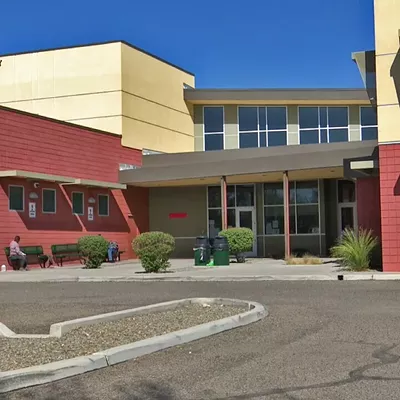While many college students were frolicking on the beaches of Mexico this past spring break, Adam Denoyer lost his friend to suicide early one March morning, but not before leaving behind notes on doorsteps for different people in his life.
Denoyer, a UA junior theater arts student, said his friend and freshman-year roommate started using drugs at the time and acknowledged he had depression. His friend also exhibited reckless behavior often and didn't seem to care about the consequences, although he eventually sought counseling. The semester following their freshman year, Denoyer's friend lived with him after his parents kicked him out.
"He took on like three jobs, a full semester load of work all at once—he was barely getting enough sleep and getting home," Denoyer said. "He just kept running hard at everything that was in front of him."
Denoyer was one of the people who received a note.
"It's always kind of a switchback between grief and anger," Denoyer said.
Stories like Denoyer's and his friend's are unfortunately not episodic or isolated occurrences. According to the Centers for Disease Control and Prevention, suicide is the third leading cause of death for people ages 10 to 14 and the second leading cause for people ages 15 to 34.
The popular recent Netflix series, 13 Reasons Why, is an adaptation of the original book with the same title by Jay Asher.
Denoyer said his friend read and praised the book before committing suicide. The plot of the book and Netflix series revolves around cassette tapes that a high school student character, Hannah Baker, leaves behind for her classmates to listen to after she commits suicide. The tapes expose the wrongdoings of her peers, blame them for mistreating her and recap physically and emotionally traumatic events Baker experienced, such as rape and consistent bullying. Denoyer is not sure when or if he will ever watch the Netflix series.
"It's the kind of thing that appealed to him a lot as something that was poetic and theatrical, that had a wide audience base and people would remember," Denoyer said. "And that seems like the kind of thing that people remember, you know?"
The series has been met with both criticism and praise, but many experts in Tucson seem to agree on at least one outcome—it has reignited a conversation about the stigma that often attaches itself to mental health and about how these topics should be portrayed in TV, film and media.
According to data from Fizziology, an international social media research firm and an official partner of Twitter the 13 Reasons Why show series was so popular that it was tweeted about more times than any other Netflix show during its first week of airing—3,585,110 times to be exact.
Sande Roberts, a certified master trainer in suicide prevention and intervention who currently lives in Phoenix, worked in the behavioral health and crisis field for over 25 years and works with high-risk teens and families. Her latest book, We Need to Talk About Suicide, aims to raise awareness about warning signs and encourage open conversation about struggling with crisis.
Roberts said she thinks media, like violent video games, can numb people to crisis like suicide.
"You kill off people and things and robots, and then you just hit a reset button and you start all over," Roberts said. "But we don't have a reset button."
When Roberts read the Thirteen Reasons Why book, she said she thought it was well-written and depicted accurate high school and middle school behaviors that can lead up to crisis such as parties with substance abuse, blaming one another, bullying and even threats of suicide if one person fears a breakup with the other in romantic relationships.
"It's tough," Roberts said. "I mean anyone who survives middle school should get a medal."
The book writes Baker's suicide as much less graphic than the scene in the Netflix show. One of the writers for the 13 Reasons Why show, Nic Sheff, wrote an Op-Ed on April 19 for Vanity Fair, in which he defended the show's graphic depiction of Baker's suicide scene.
Sheff reveals he has struggled with crystal-meth addiction and a suicide attempt himself, motivating him even more to be a part of the Netflix project. Sheff shares in the article that what stopped him from completing his own suicide was remembering a young woman's recovery story she had shared during a group therapy session beforehand. He writes the memory of that woman sharing her story saved his life.
"It seemed to me the perfect opportunity to show what an actual suicide really looks like — to dispel the myth of the quiet drifting off, and to make viewers face the reality of what happens when you jump from a burning building into something much, much worse," Sheff writes. "It overwhelmingly seems to me that the most irresponsible thing we could've done would have been not to show the death at all."
Roberts said she understands why writing a gruesome scene for Baker's suicide could be an attempt to dissuade people from attempting suicide themselves, but she doesn't like the "how-to" effect that could result from showing an entire suicide scene in detail.
This effect has a name according to Glenn Matchett-Morris, the associate director for Counseling and Psych services, CAPS, at the UA. The effect is called "suicide contagion."
"It is when someone else thinks about or completes a suicide after someone else dies by suicide," Matchett-Morris said in an email. "It is believed that some of the contributing factors include sensationalizing the original suicide, giving details about where and how the suicide was completed, presenting simplistic explanations for suicide and suggesting that suicide is a common way that people deal with adversity."
Tweets with memes about the show that have gone viral have sparked some debate that people shouldn't need a popular show to know to treat one another nicely or at the very least, to know not to bully others.
"Oh, yes they do," Roberts said. "People are terrible to each other. They are terrible to each other in middle school; they are terrible to each other in high school. It doesn't necessarily get any better in college."
Roberts said the best way to help friends, family or loved ones cope with mental health struggles is just to listen without attempting to tell the person in crisis what they think they should do or feel. She also wrote an article, "Ten Things Every Parent Needs To Know About Why Teens Contemplate Suicide," which summarizes warning signs of crisis and coping strategies.
"While some may think it takes courage for teens to kill themselves, it does not," Roberts writes in the article. "It does take courage for them to pull themselves out of bed some days to deal with everything."
Matchett-Morris said in an email while she hasn't watched the Netflix series, some have perceived Baker's suicide as a romantic or heroic act.
"Suicide is neither of those," she said via email. "It is also indicated that her death is the fault of others who have mistreated or hurt her. While those events are sad and very unfortunate, suicide is never someone else's fault. The portrayal, true or not, of the counselor in the show is very unfortunate, and could discourage viewers from seeking counseling."
According to Matchett-Morris, six percent of college students (nationally and at UA) seriously consider suicide every year. About one percent actually attempts suicide. Converted to numbers, Matchett-Morris said via email, those percentages equate to about 2,500 UA students seriously considering suicide and over 400 attempting it.
Tyler Woods is a holistic health care provider for the grief support group, Survivors of Suicide Tucson, and said the more people talk about suicide prevention, the better. Woods said media represent suicide horribly and tend to glorify it.
"Mental health issues are no different than if we had cancer or something," Woods said. "We have an emotional immune system too."
The National Association of School Psychologists posted a memo online about the Netflix series, writing many youth can differentiate between a television drama and reality, but engaging in conversation about the show is still recommended.
NASP also cautioned that any vulnerable youth do not watch the series, stating it can lead viewers to romanticize the choices Baker makes "and/or develop revenge fantasies."
H. Clarke Romans, executive director of the National Alliance on Mental Illness Southern Arizona branch, said the organization provides educational programs (many in English and Spanish), support and advocacy for people and families struggling with mental health. Help from the organization is free and no one has to meet any type of eligibility or insurance requirements to be admitted.
"Ignorance about mental illness is massive, pervasive and mostly wrong," Romans said. "In other words, people in society really don't know anything about mental illness, generally."
Romans said he thinks the increase in conversation about mental illness on television, film and radio today can be positive because the more people want to talk about the issue, the more normalized it can be without the taboo. Avoiding the portrayal of mental illness as hysteria on these mediums is critical though, according to Romans.
He said the movie, "A Beautiful Mind," which features a brilliant genius main character with schizophrenia, was a turning point for the better in media's portrayal of mental illness because it helped to identify that mental illness and intelligence can be separate entities of someone's mind.
He said he wants the community to educate itself on mental illness and understand that these issues can be treated.
"People can live healthful, successful lives with these disorders," Romans said.
A little over a month after the death of his friend, Denoyer sits at his kitchen table reflecting on the signs leading up to his friend's decision to commit suicide. Still shaken up by it, he said seeking help and people that will listen is extremely important for people struggling with suicidal thoughts.
"You have to be present with all the people in your life," Denoyer said, "and you have to connect with them as much as you can, while you can."
National Suicide Prevention Lifeline: 1-800-273-8255
National Alliance on Mental Illness Southern Arizona: (520) 622-5582
Survivors of Suicide Tucson support group: (520) 323-8660








